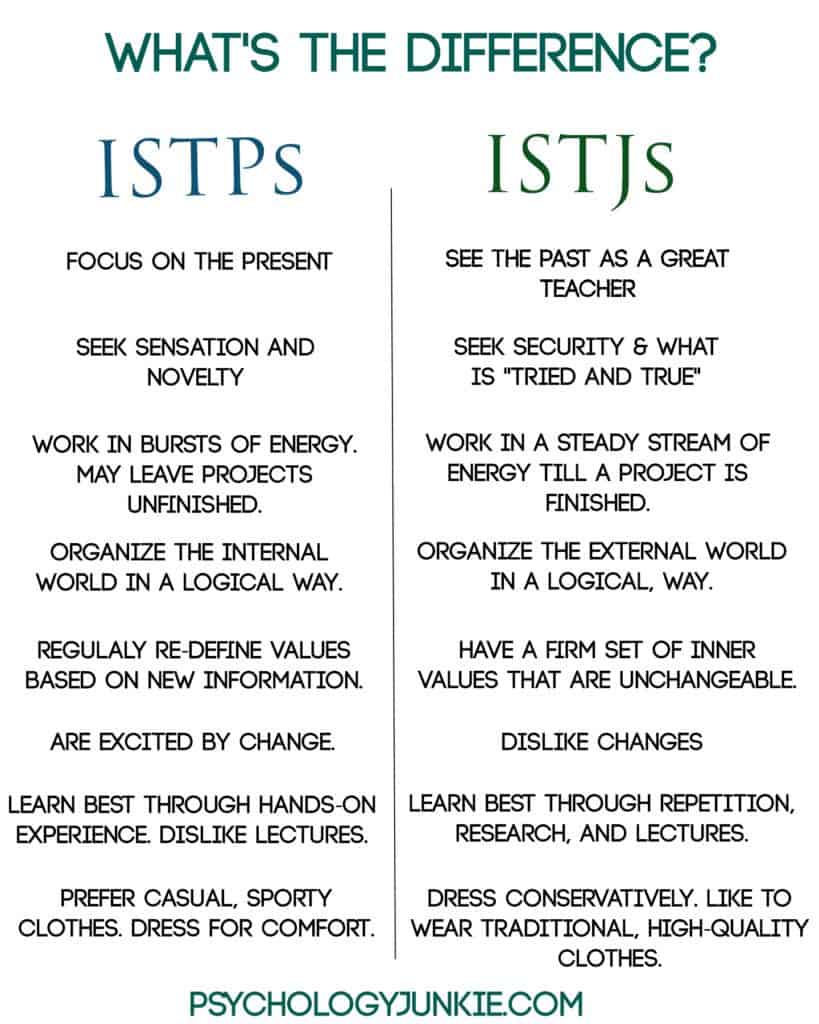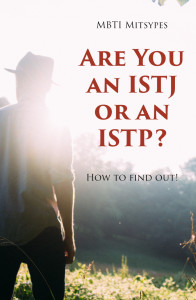ISTJ vs ISTP: Which One Are You?
One of the most common mistypes in the typology world is the ISTP or ISTJ mistype. I’ve met many ISTPs who consistently get ISTJ results on personality tests. ISTPs are often mistyped as ISTJs or vice versa. There are a lot of reasons for this, but one of the main reasons is that ISTPs have a dominant judging function, introverted thinking. This is an internalized function, so the outside world may not see it very often, but ISTPs are very aware of it themselves. So when taking the Myers-Briggs test, ISTPs will often answer in a more ‘judger’ fashion than the test is expecting and they will get placed in the ISTJ category.
This is yet another reason why I try to discourage people from taking the test result too seriously.

Estimated reading time: 9 minutes
How should I figure out my type?
The tests (especially the free online tests) tend to focus primarily on binary choices (are you a feeler or thinker? sensor or intuitive?) without taking into consideration the cognitive functions themselves – do you use extraverted or introverted feeling? Are you an extraverted sensor or an introverted sensor?
The best way to define your type is to do one or all of the following:
A- Study Jung’s cognitive functions and determine which ones you use.
B – Talk to someone who is a total Myers-Briggs® nerd and can help you with it
C – Talk to a certified MBTI® practitioner.
D – Take the free online test, read profiles of that type to see if they match up, and then read profiles of similar types to see if one seems to ‘fit’ you better.
Okay, so back to the topic at hand. ISTP or ISTJ – that is the question! How do you figure out which one you are? Well, as always, let’s take a look at their cognitive functions.
The ISTJ cognitive functions are:
Introverted Sensing
Extraverted Thinking
Introverted Feeling
Extraverted Intuition
The ISTP cognitive functions are:
Introverted Thinking
Extraverted Sensing
Introverted Intuition
Extraverted Feeling
Notice anything unusual? These two types – while they are both introverts, sensors, and thinkers, share ZERO cognitive functions. I’ve seen people say “I drift between ISTJ/P depending on my mood” – well, if you know your cognitive functions, you know that can’t be true. You’d have to completely reverse all your functions to do that. ISTPs and ISTJs are actually more dissimilar than they would appear at first glance.
The ISTP Artisan Vs. The ISTJ Guardian
ISTPs fall into the MBTI category of Artisan. MBTI® expert and psychologist David Kiersey calls them the “Tactical Crafters”. They are often masters of tools, weapons, or machinery, and they are usually incredibly skilled at building and constructing. They live in the here and now and are often spontaneous and adaptable. SPs are flexible and adventurous, with a desire to be free from boundaries and pointless rules that could keep them from making new discoveries. ISTPs live impulsively, thrive in hands-on occupations, and are excellent at solving problems or helping in a crisis.
ISTJs fall into the MBTI category of Guardian. David Kiersey calls them the “Inspectors”. These detail-oriented and responsible individuals usually have an incredible memory of the past, due to their dominant introverted sensing (Si). They have storehouses of information locked inside their minds, and they are excellent at using this information to solve a problem. They are very practical and don’t like to be showy or effusive. They consider the past an excellent teacher for the future, and often seek the wisdom of the men (or women) who came before them as they go forward into the future. SJ types tend to be down to earth, good at getting jobs done, and highly logical.

I put this chart together (above) to show some of the more stereotypical differences between these types. Sure, ISTJs are capable of focusing on the present and ISTPs are capable of learning from the past – but each has a tendency to favor one over the other, and it comes down to the cognitive functions. We’re going to talk a little about each types dominant function here, to get an idea of the differences.
ISTP and ISTJ Thinking Preferences
ISTPs use introverted thinking while ISTJs use extraverted thinking. Because of this, ISTPs keep their dominant decision-making process (thinking) internalized, while ISTJs keep their decision-making process (thinking) externalized. How does this show itself?
ISTJ Extraverted Thinking
Although quiet and private in nature, the ISTJ may think through their decisions out loud or organize their decisions externally. They like to take notes and look at books or manuals. They may have to-do lists or white boards with their plans listed in order. They are concerned with organizing their outer world and are usually good at delegating to get a job done. Once they have learned a solution, they don’t like to mess with it. If it ain’t broke, don’t fix it! They will then move on to the next project. They are extremely organized externally.
ISTP Introverted Thinking
ISTPs have an internal decision-making process, so the outside world will rarely know what is going on inside the ISTP’s mind when they make a decision about something. They don’t think through their choices out loud, and they are constantly re-defining a process or plan based on new information. They don’t particularly like delegating and prefer to work alone in their own experimental, hands-on way. They enjoy finding out the principle behind something, and taking things completely apart to understand how they work. They are less focused on completing a project then understanding how the thing works completely before getting started. They are extremely organized internally.
ISTP and ISTJ Sensing Preferences
ISTJ and Introverted Sensing
ISTJs use Introverted Sensing (Si). This gives them a keen awareness of their inner body (for example, sensations such as hunger or illness). This also makes them extremely aware of details and facts from their past experiences. They will often look back at past memories, studies, and research to make a decision. Si-users love traditions, which is why they are called the Guardians – without Guardians a lot of our traditions and sense of history would be gone. ISTJs preserve the past, enjoy routine, can be nostalgic, and enjoy the familiar, simple pleasures of life. They focus on the past as a way of moving forward into a better future.
ISTP and Extraverted Sensing
ISTPs use Extraverted Sensing (Se). This gives them a powerful awareness of their present surroundings, and how to use their body in the outside world. Because of this, Se-users are often good at physically manipulating their environment and immersing themselves in opportunities that show up spontaneously. For some ISTPs this shows up as a proclivity for sports, dancing, or even gardening. ISTPs use Se to seek sensation in the outside world. They love to live a flexible, free life, take in lots of new, sensory experiences. ISTPs live life “on the edge” and like to test their physical limits. They live completely in the moment and are very adaptable. They tend to think quickly in a crisis and are excellent at coming up with efficient ways to solve a problem in an emergency, even without any detailed information in front of them. They focus less on the past, worry less about the future, and are generally optimists.
ISTP and ISTJ Under Stress
One of the best ways to really understand your type and make sure you are typed correctly is to figure out how you react to stress. ISTPs and ISTJs react to stress very differently.
ISTJs and Stress
ISTJs when first experiencing stress tend to feel tired and overwhelmed. They may try to solve a problem by first using introverted sensing. They will try to focus on the details and data of the situation that is causing them stress, and figure out what has worked in the past to solve it. In their efforts to solve the problem, they may come off to others as irritable, inflexible, or impatient.
If stress increases, the ISTJ may wear out their dominant function and fall “into the grip” of their inferior function; extraverted intuition. This is when the ISTJ goes into “catastrophe mode” and can see nothing but the potential of what could go wrong. They can become overwhelmed and depressed about what they see as a bleak future, embracing an overwhelming fear of what is to come.
You can find out more about ISTJs stress reactions (and how to help) here.
ISTPs and Stress
ISTPs are very private about what stresses them out. When they first experience stress, they’ll try to “fix” the problem through a logical solution, using introverted thinking. If the problem continues, and it can’t be fixed, they may wear out their dominant function and fall “into the grip” of their inferior function – extraverted feeling. When this happens, they may become uncharacteristically emotional, hypersensitive about their relationships, and may misinterpret small, insignificant details as signs that others dislike or hate them.
Because of the ISTP’s tendency to be optimistic and make the best of the present moment, they are often able to manage their stress quickly. However, every person is different and there are definitely exceptions to this “rule”. An ISTP in a lifestyle that doesn’t suit his or her strengths can be incredibly stressed out on a regular basis.
You can find out more about ISTPs stress reactions (and how to help) here.
In Conclusion
ISTPs and ISTJs have a lot of characteristics that make them unique from each other. Both are incredible personalities and a lot of fun to be around. I’ve been a member of several ISTP and ISTJ groups on the internet, and they are some of the most entertaining, humorous groups of people I’ve come into contact with. I love how down to earth both types are. My hope is that they will feel I didn’t let them down with my analysis of their differences! Let me know if you have any thoughts or comments!
Find out more about your personality type in our eBook, Discovering You: Unlocking the Power of Personality Type.

Subscribe to Our Newsletter

Want to discover more about personality type? Get the inside scoop with Susan Storm on all things typological, along with special subscriber freebies, and discounts on new eBooks and courses! Join our newsletter today!












Hello.
Your article is very accurate, and very helpful for me, because i’m having a problem with typing myself.
I took many tests, even cognitive function tests, and selftyping, but i’m still not sure what my type is.
I narrowed it down to ISTP vs ISTJ, but i might me something else. I have even problems with determining my dominant function. Don’t get me wrong. I study MBTI for like 4 years. But that’s maybe the problem. I can’t analyze myself that well. Could you please help me? Of course i could just spend days googling through thousands of websites, but i’ve found your approach and understanding of MBTI very similiar and likeable.
Could you contact me (or i could contact you) and have small discussion about this? Or if not, could you make few articles about the differences, please? I think that with your knowledge you would be the person which would help me solve my problem. Everything else failed, including forums. Thank you in advance for your response.
Have a good day.
I remember a teacher who made us swallow historical dates during one year. A normal period for an ISTJ. Hard for me.
I need to feel the exceptional nature of a period, anecdotes, risk taking, inequity.
And after some dates.
Otherwise, for an STP, the narratives of explorers (Cook) or warrior (Caesar) are excellent means of study History as a whole.
I must be close to 50/50 because this didn’t clear anything up for me at all but I do appreciate your efforts.
I have not found the P/J dichotomy a problem. Rather, the N/S. I always start with my J function and get derailed by my P function during the day. An ISTP is in plan mode (because T and F are J functions) out of the gate but easily and happily change once the perceiving function (Se or Ne) takes over, usually before I’ve finished my second cup of tea. ???? Because INTP and ISTP share dominant and inferior functions, I find it much more difficult to differentiate between them. I know what I’m good with and what I’m bad with, but the middle functions are more confusing. Where can one find decent explanations. Maybe a post specifically dealing with that?
This happened to me too. I had more problem with the N/S thing. But I guess we are Ti doms and it is normal to have those results and we have teartiary Ni, so it can be another factor there, who knows, but Ti doms after all. I have never got J. I know I am ISTP because I have an INTP father, we have similudes but diffrences. I found ISTP more stoic (or somthing like that) than INTPs, from what I have met in real life (I know other INTPs and ISTPs).
im also combined 50/50. can be anoying somethimes..
ISTP think with a modular plan, he is tactician. ISTJ is definitive and more accurate in the time, he is logistician.
The most eficciency to difference each other is how they express, ISTJs tend to use that Te function that is very remarkable when you are talking to them, and ISTPs tend to have their judgmental things private until they are appropiate to tell something, it is like they process more due to the options to make an conclusion, it is time to process. I have an ISTJ brother and we are very different. And another thing is that ISTJs have more social skills than ISTPs. Our faith is alow, we do not follow “social rules” it is blind to us.
Our Fe*
I would say ISTP: «focus on the present» (Se) with a a glance toward the future. (Ni)
I’m an ISTJ, a man with a plan, and being adaptable always be on my list.
I love risk-taking activities and live life on the edge, but I’d had to make sure everything is safe (or at least have fail-safe plan).
I love to live in a safe and secure environment, but I also love to make a ruckus just to feel the greatest level of satisfaction seeing how people react to it, I just need to make sure that I wont take the blame.
I feel comfort and secure, living as ISTJ.
I love Law and Rules, it gives me security, and I love play with it.
My friends always see me as an ISTP with plan and neat & tidy style.
I Smite Things Judiciously
This article is pretty accurate. I’m an ISTP, and my husband is an ISTJ.. and we think nothing alike. His Te likes to discuss everything out loud… and I have to process it all internally before I can share what I’m thinking. I guess after living with him, I have a hard time imagining mixing up the two types cause they’re so drastically different in my mind.
I can so relate! You are so correct!
I have to process everything inside first also. Much of the time I have little to say to others. I can do small talk well but prefer to not. I’m an istp.
Omg but wait, in the chart i identify most like an ISTP, after that, when you explain the thinking preference, i’m an ISTP who tends to become more and more ISTJ (to do lists, for example, are better than i thought. I just needed to make my own plan of it instead of trying to use a model already developped) and sensing preferences i identify way WAY more to ISTJ, and when it comes to stress i’m back on a definite ISTP.
But when i read about them both 9on the official site for example), maybe 85% of ISTP is accurate for me when ISTJ is 100%, but i feel like there’s really a part missing in ISTJ’s description, with the social interactions being completely messy (that is the big big part that comes right in my heart with ISTP)
I think that ISTP is me on a normal life level, and ISTJ is when it comes to work or school.
omg same!! last time i took the test, the result was istp. i took the test again just now and the result is istj!! i don’t know anymoree
This article helped me a lot. I have had both results when taking the MBTI. It was kind of driving me crazy. But your comparisons and insights showed me that I am more consistently an ISTJ. It just fits better. I really appreciated this breakdown. Thank you, ISTJ Dana.